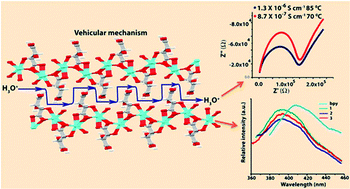Synthesis, characterisation, water adsorption and proton conductivity of three Cd(ii) based luminescent metal–organic frameworks†
Abstract
Three hydrogen bonded three-dimensional (3D) metal–organic frameworks (MOFs) namely [Cd(L-tart)(bpy)(H2O)]n·9n(H2O) (1), [Cd(D-tart)(bpy)(H2O)]n·9n(H2O) (2) and [Cd(DL-tart)(bpy)(H2O)]n·6n(H2O) (3) (tart = tartaric acid, bpy = 4,4-bipyridine) have been synthesized by the solvent diffusion technique at room temperature. Compounds 1 and 2 have been characterized by single crystal X-ray analysis, whereas the powder X-ray diffraction patterns show that the structural integrity of compound 3 is similar to 1 and 2. Structural analysis of 1 and 2 shows H-bonded homochiral 3D MOFs, fabricated by the hydrogen bonding interactions between the nearby 2D pillared-layer frameworks through the metal-bound water, metal-bound carboxylate, free carboxylic acid and the hydroxy group of L-/D- tart. The absolute configuration of all the compounds was investigated by solid state circular dichroism (CD) spectroscopy, which signifies that 1 and 2 are enantiomers whereas 3 is racemic. The adsorption studies reveal that compounds 1–3 show a significant amount of uptake for water vapor (∼239 mL g−1 for 1, ∼240 mL g−1 in 2, whereas 184 mL g−1 for 3 at P/P0 ≈ 1 bar) over other solvents (MeOH, EtOH) and an impedance measurement indicates that these compounds show proton conduction (1.3 × 10−6 S cm−1 in 1, 1.3 × 10−6 S cm−1 in 2 and 4.5 × 10−7 S cm−1 in 3) at a higher temperature (358 K) and at 95% relative humidity. The observed conductivity is explained by the so-called vehicle mechanism (activation energy (Ea) = 0.63–0.77 eV). Since all the compounds contain H3O+ cations in the interlayer space, the hydronium ions might act as vehicles to transport the protons in the interlayer space. The photoluminescence properties of all the compounds are also reported.



 Please wait while we load your content...
Please wait while we load your content...